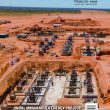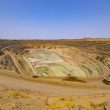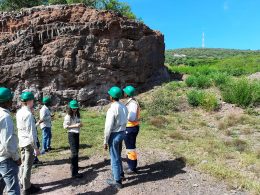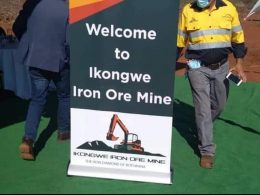The global diamond industry has endured bouts of uncertainties since the 2008 financial crisis. From 2008 financial crisis to the COVID-19 pandemic, it was a decade of unpredictability, which hampered continued global economic growth.
De Beers Group — the world’s leading diamond company with expertise in the exploration, mining and marketing of diamonds — was not spared from the feeling the brunt of the 2008 financial crisis which ultimately caused a global recession.
In line with most products in the luxury goods sector, the diamond industry was severely affected by the global recession. Reduced consumer demand, constricted liquidity and high levels of inventory in the pipeline combined to produce particularly challenging economic conditions for rough diamonds.
2009 was a year of unprecedented challenges, but De Beers met them head-on with determination and resolve. As the magnitude of the economic crisis became apparent toward the end of 2008, De Beers instituted a pro-active 6 Point Recession Action Plan to address its commercial vulnerabilities and ensure the company was positioned for growth once recession gave way to recovery. These actions helped De Beers’ clients to reduce their inventories of rough and polished diamonds, and debt levels.
Despite exceptionally difficult trading conditions, which saw De Beers’ sales decline from US$6.89 billion in 2008 to US$3.84 billion in 2009, De Beers exceeded its primary sales and cost targets, and remained cash positive for the year. The 6 Point Recession Action Plan were: Keep safety as top priority; Maximise demand opportunities; Produce in line with client demand; Drive cost reductions across the business; Enhance operating efficiencies, and Focus on cash management.
By 2014, trading conditions had improved and global demand for diamonds reached record levels. This period was however short-lived, as soon after, the geo-political tensions, owing to deterioration in the United States – China relations, set the industry on the back foot once again.
The US-China concerns were eclipsed by the outbreak of COVID-19. The diamond industry had started 2020 positively after a strong US holiday season at the end of 2019, with robust demand for rough diamonds but the outbreak of the contagious virus, and measures taken by governments in response, had a profound impact on global diamond supply and demand.
On the 11th of March 2020, the World Health Organisation (WHO) declared Corona Virus Disease 2019 (COVID-19) a pandemic. In the first quarter of 2020, much of the industry was temporarily unable to operate, with up to 90 percent of jewellery stores closed at the peak of lockdowns, first in China, then in Europe and the US.
The measures imposed by governments; lockdowns and travel restrictions, saw the pandemic metamorphosing also into an economic problem. De Beers Group, the world’s largest diamond producer by value, responded swiftly to the development. The magnitude of the impact of COVID-19 meant the company had to deploy drastic and unprecedented measures, to protect its employees and maintain rapport with its customers.
“When the United States went into lockdown, we started for the first time thinking about cancelling the sight, and we have not cancelled the sight since the Second World War,” recalled De Beers Executive Vice President – Diamond Trading, Paul Rowley in an exclusive interview with The Projects Magazine.
“We wanted to ensure across all of our operations globally that everyone was in a safe position. Within the De Beers/Anglo Group, safety always comes first; our number one priority was to make sure that we have understood its [COVID-19] severity and we put suitable measures in place to ensure that we were protecting all our employees.”
The closure of the world meant the usual diamond trading activities were affected. De Beers primary focus was to ensure that the market remained confident about future supply . The company leadership rose to the occasion, facilitating communication with analysts, clients, producers and government partners, to make sure that there was an alignment on ensuring that the diamond industry would fare well into the future amid a lot of uncertainty.
“An important part of that was to ensure our customers knew that we would provide them with flexibility in their purchases so that we did not harm value by encouraging purchases of supply for which there was no demand. . We understood the situation, and our minds were focused on adjusting production levels to reflect prevailing demand,” said Rowley.
Lockdowns, and travel restriction meant that during the pandemic, De Beers Group officials were working remotely. At the time, Rowley, was in the United Kingdom, coordinating responses from there with other colleagues across the world. De Beers embraced Microsoft Teams, which allowed them to continue doing business.
“We had a good start to the year with strong sales in the first 2 sights, however this was followed by a big reduction in Q2 once the pandemic took hold. . I remember from our sales at the time that there was 1 sight where we literally sold nothing. During the second quarter we sold about $100 million, which is just a small fraction of what De Beers would normally sell over such a period. said Rowley.
De Beers did not despair, it sold through other routes, assisting customers when they needed goods. De Beers also looked to shipping goods around the globe to different centers.
“We created opportunities for our clients to view goods in Dubai, Singapore and Belgium.. That is how we started to see the sales picking up into the second-half of 2020,” Rowley indicated.
Rowley said, diamonds are such a special product — they represent love and relationships and the celebration of important milestones — so during difficult times consumers continued buying luxury products. The closure of China, and the US, affected the sales drastically. However, the world quickly re-adjusted and we saw more clients migrating to online purchases, as the use of technology took centre stage.
According to Rowley, 2021 was a record year, with De Beers benefiting from the absence of travel and experiential spending and other competing products.
“We did benefit from what we refer to as a share of wallet through that period of time. We particularly saw luxury doing exceptionally well and that has continued into the first quarter of this year [2022].”
Despite sales picking up once again, COVID-19 pandemic is not officially over. The world remains what De Beers Executive Vice President- Diamond Trading terms – a VUCA World (Volatile, Uncertain, Complex and Ambiguous). The markets have started opening up, but China, one of the biggest markets, has experienced further lockdowns..
“We are far from beyond COVID, and are still having to adjust. We are right in the middle of the VUCA world and we continue to adapt accordingly,” Rowley said.
In the midst of COVID-19, the diamond industry has continued to play a major role in the economy of Botswana. Diamond revenues are the largest contributor to the Gross Domestic Product (GDP) and government earnings. Notwithstanding that verity, at the height of COVID-19, government imposed a State of Emergence. . The State of Emergency started in April 2020, and came to an end on the 30th of September 2021.
“We were closed for a long time to people coming in. That is where the remote viewing was very important, but at the same time we were able to also support all the local factories, and likewise in Namibia and South Africa,” he said.
“It’s been quite a challenge over the period, but the diamond industry, in its entirety has shown incredible resilience. It pulled together, and it actually worked really well collaboratively across that pipeline all the way from the mines through to the consumer. The collaboration and pulling together is what has really seen the industry through.”
THE DE BEERS FUTURE OUTLOOK
De Beers remains a key player in the global diamond industry. It is the world’s largest diamond producer by value, and heading into the future, the company continues to exert its influence with key investment, including embracing technological advancements and expanding its footprint.
“The production and returns from these investments like Jwaneng Cut 9 is some 7-8 years down the line. It shows the long term confidence of the De Beers – Anglo Group in the future of the diamond industry,” said Rowley.
“Likewise in Venetia, in South Africa, we have made a significant investment in the underground project which we hope to really see successfully completed within the expected timelines.”
JWANENG CUT 9 AND UNDERGROUND PROJECT
Through Debswana, a joint venture between De Beers and the Botswana Government, the world’s most valuable diamond mine is undergoing expansion. The Jwaneng Cut 9 Project is an expansion project which will extend the life of the mine to 2035 with 80 percent plant ore feed expected from 2029.
Debswana, after operating a sustained, profitable open pit mining environment for over fifty years, has forecasted the same favourable production levels over the next 15 to 20 years. However, it has been resolved after a business case evaluation that post Cut 9, it will not be feasible for the mine to continue with open pit, hence there will be need to go underground.
BENGUELA GEM VESSEL
In March 2022, De Beers Group officially unveiled the world’s largest, most advanced, and most environmentally friendly diamond recovery vessel, the Benguela Gem, in Namibia at an inauguration ceremony attended by President of Namibia, Hage Geingob, Minister of Mines and Energy, Tom Alweendo and De Beers Group CEO, Bruce Cleaver. The vessel commenced its operations a week after its launch, which was ahead of its original schedule.
The US$420 million custom-built vessel will add an additional 500,000 carats of high value diamonds to Debmarine Namibia’s annual production, an increase of around 45 per cent, while creating 160 high-skilled jobs for Namibians.
Debmarine Namibia is a 50/50 joint venture between De Beers Group and the Government of the Republic of Namibia. The Benguela Gem joined the world-class Debmarine Namibia fleet, which responsibly recovers some of the world’s highest quality diamonds.
EXPANSION TO ANGOLA
In April 2022, De Beers Group announced it has signed two Mineral Investment Contracts (MICs) with the Government of Angola for licence areas in north-eastern Angola. The signing of the MICs followed the announcement in late 2021 that De Beers had applied to explore in Angola following substantive reforms in the country’s diamond sector.
The MICs for the two licence areas are for the award and exercise of mineral rights covering all stages of diamond resource development, from exploration to mining, and span a period of 35 years. Each concession area will be held by a separate new joint venture company formed by De Beers Group and Endiama, Angola’s state-owned diamond company. De Beers Group will hold a substantial majority in the new companies, with Endiama having the ability to incrementally increase its equity share over time in line with certain conditions outlined in the shareholder agreements, albeit with De Beers Group maintaining a substantial majority.
VENETIA MINE
The De Beers Group in 2013 began construction of a new underground mine beneath its open pit Venetia Mine in Limpopo Province, South Africa. The investment will extend the life of Venetia beyond 2040 and will retain Venitia’s position as South Africa’s largest diamond mine.
The underground production is expected to commence in 2023 or 2024 and, over its life, the Mine will treat approximately 134 metric tonnes of ore, containing an estimated 88 million carats. The mine will also support over 8,000 jobs directly, and a further 5,000 through the supply chain.
NATURAL DIAMONDS VERSUS SYTHETICS
In May 2018, De Beers Group announced the launch of a new company called Lightbox Jewelry that will begin marketing a new brand of laboratory-grown diamond jewelry under the Lightbox name in September, offering consumers high-quality, fashion jewelry designs at lower prices than existing lab-grown diamond offerings.
During the launch De Beers indicated that it has learned from research that there is a lot of confusion about lab-grown diamonds – what they are, how they differ from natural diamonds, and how they are valued. Lightbox was established essentially to help consumers understand lab-grown diamonds better e and also offer pricing that is consistent with the production and long term value.
De Beers believes, as a natural diamond company, it is not concerned about the possibility of synthetics completing with natural diamond sales , as the two products will co-exist because they serve different markets — but natural diamonds will continue to be more valuable.
“There will always be some form of cannibalisation, but ultimately we are seeing them actually grow at different levels. Last year is a great example. Lab grown diamonds fell in price over that period whereas natural diamonds over the same period saw an increase in price. They serve two very different markets,” said Rowley.








